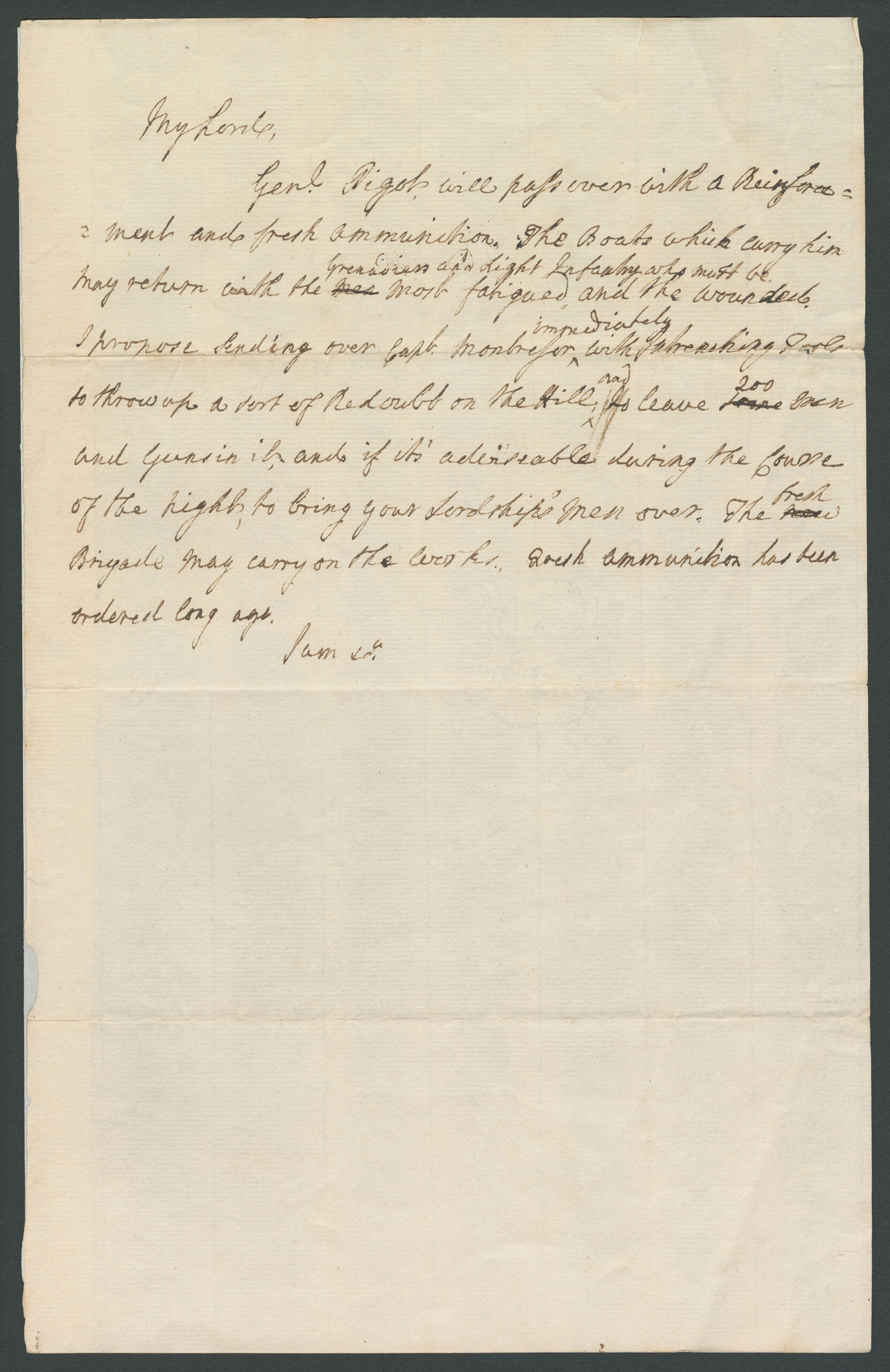Expecting a Tumult: March–April 17, 1775
Expecting a Tumult: March–April 17, 1775
In the weeks preceding the outbreak of violence at Lexington and Concord, conflict was deepening. The letters in this case provide glimpses into ways this manifested across different walks of life.
[Item 5]. John Hancock autograph letter signed to [Cælia] Boyle, April 8, 1775; Lexington, [Province of Massachusetts Bay]. From the collection of Dr. Gary Milan, loaned in memory of Joyce Kliger.
Access the full letter, transcription, and audio recording here.
John Hancock was one of the most prominent revolutionaries in Massachusetts, having been prominently engaged in oppositional politics since the 1760s that made him a key target. On April 7th, Paul Revere rode to Concord, where Hancock was attending the provincial congress, warning that troops might be moving to seize stores and make arrests. To avoid imprisonment, Hancock opted to stay in Lexington where he wrote to his aide’s wife who had remained in the city [ITEM 5]. Amidst the simmering threat of violence, Hancock was concerned about the practical matters of a family unable to return home. He made arrangements for packing a trunk of his fianceé’s belongings, and sending its key and her purple dress. The countryside was on alert, including Deacon Jonathan Hosmer of Acton. On April 10, he wrote to his daughter and/or son-in-law, stating that daily they expected a tumult, referencing the false alarm by Revere, and adding his belief that if Regular soldiers did come out to Concord “there will be bloody work” [ITEM 6].
[Item 6]. Jonathan Hosmer autograph letter signed to [Oliver and/or Sarah Hosmer Stevens], April 10, 1775; Acton, [Province of Massachusetts Bay]. From the collection of Dr. Gary Milan, loaned in memory of Joyce Kliger.
Access the full letter, transcription, and audio recording here.
[Item 7]. John Westcott autograph letter signed to “Dr. Sir”, April 18, 1775; Boston, [Province of Massachusetts Bay]. From the collection of Dr. Gary Milan, loaned in memory of Joyce Kliger.
Access the full letter, transcription, and audio recording here.
John Westcott, a British sailor, was waiting to board his ship at Boston. He wrote that John Hancock, Samuel Adams, “The Printer” Isaiah Thomas, other patriot leaders, and everyday people had fled the city, remarking that “the people in the Countrey arming Them selves ripe for Rebelion.” [ITEM 7].
Meanwhile, on April 14 Thomas Gage opened a confidential letter from his superior, Secretary of State for the Colonies, the Earl of Dartmouth, that had taken nearly three months to reach its transatlantic destination [ITEM 8 is the copy Gage received April 16]. With clear irritation at Gage’s hesitations, the Secretary disregarded the General’s insistence that he would need 20,000 soldiers to put down the revolt underway and offered far fewer reinforcements. Dartmouth explained the legal justification for using force against the rebellious colonists, acknowledging that affairs in America “are now come to a Crisis in which the Government of this Country must act with firmness and decision.”
[Item 8]. [William Legge, 2nd Earl of] Dartmouth letter signed to [Thomas] Gage, January 27, 1775; Whitehall, [London]. From the Thomas Gage Papers, English Series.
Access the full letter, transcription, and audio recording here.

![5 - gm loan-print and mss-hancock Portrait of John Hancock beside John Hancock autograph letter signed to [Cælia] Boyle, April 8, 1775; Lexington, [Province of Massachusetts Bay].](https://clements.umich.edu/wp-content/uploads/2025/04/5-gm-loan-print-and-mss-hancock--scaled.jpg)
![6.1 gm loan-jon hosmer letter april 10, 1775-pp.1 Page 1 and Signatory Page of Jonathan Hosmer autograph letter signed to [Oliver and/or Sarah Hosmer Stevens], April 10, 1775; Acton, [Province of Massachusetts Bay]. Manuscript Letter.](https://clements.umich.edu/wp-content/uploads/2025/04/6.1-gm-loan-jon-hosmer-letter-april-10-1775-pp.1.jpg)
![7.1 gm loan-jon westcott april 18, 1775-pp.1 Page 1 of John Westcott autograph letter signed to “Dr. Sir”, April 18, 1775; Boston, [Province of Massachusetts Bay]. Manuscript Letter.](https://clements.umich.edu/wp-content/uploads/2025/04/7.1-gm-loan-jon-westcott-april-18-1775-pp.1-scaled.jpg)
![Page 1 of [William Legge, 2nd Earl of] Dartmouth letter signed to [Thomas] Gage, January 27, 1775; Whitehall, [London]. Manuscript Letter.](https://clements.umich.edu/wp-content/uploads/2025/04/8.1-00012220-scaled.jpg)
![Page 2 of [William Legge, 2nd Earl of] Dartmouth letter signed to [Thomas] Gage, January 27, 1775; Whitehall, [London]. Manuscript Letter.](https://clements.umich.edu/wp-content/uploads/2025/04/8.2-00012221-scaled.jpg)
![Page 3 of [William Legge, 2nd Earl of] Dartmouth letter signed to [Thomas] Gage, January 27, 1775; Whitehall, [London]. Manuscript Letter.](https://clements.umich.edu/wp-content/uploads/2025/04/8.3-00012222-scaled.jpg)
![Page 4 of [William Legge, 2nd Earl of] Dartmouth letter signed to [Thomas] Gage, January 27, 1775; Whitehall, [London]. Manuscript Letter.](https://clements.umich.edu/wp-content/uploads/2025/04/8.4-00012223-400x516.jpg)
![Page 5 of [William Legge, 2nd Earl of] Dartmouth letter signed to [Thomas] Gage, January 27, 1775; Whitehall, [London]. Manuscript Letter.](https://clements.umich.edu/wp-content/uploads/2025/04/8.5-00012224-scaled.jpg)
![Page 16of [William Legge, 2nd Earl of] Dartmouth letter signed to [Thomas] Gage, January 27, 1775; Whitehall, [London]. Manuscript Letter.](https://clements.umich.edu/wp-content/uploads/2025/04/8.6-00012225-scaled.jpg)
![Page 7 of [William Legge, 2nd Earl of] Dartmouth letter signed to [Thomas] Gage, January 27, 1775; Whitehall, [London]. Manuscript Letter.](https://clements.umich.edu/wp-content/uploads/2025/04/8.7-00012226-scaled.jpg)
![Page 8 of [William Legge, 2nd Earl of] Dartmouth letter signed to [Thomas] Gage, January 27, 1775; Whitehall, [London]. Manuscript Letter.](https://clements.umich.edu/wp-content/uploads/2025/04/8.8-00012227-400x516.jpg)
![Page 9 of [William Legge, 2nd Earl of] Dartmouth letter signed to [Thomas] Gage, January 27, 1775; Whitehall, [London]. Manuscript Letter.](https://clements.umich.edu/wp-content/uploads/2025/04/8.9-00012228-scaled.jpg)
![Page 10 of [William Legge, 2nd Earl of] Dartmouth letter signed to [Thomas] Gage, January 27, 1775; Whitehall, [London]. Manuscript Letter.](https://clements.umich.edu/wp-content/uploads/2025/04/8.10-00012229-scaled.jpg)
![Page 11 of [William Legge, 2nd Earl of] Dartmouth letter signed to [Thomas] Gage, January 27, 1775; Whitehall, [London]. Manuscript Letter.](https://clements.umich.edu/wp-content/uploads/2025/04/8.11-00012230-scaled.jpg)
![Page 12 of [William Legge, 2nd Earl of] Dartmouth letter signed to [Thomas] Gage, January 27, 1775; Whitehall, [London]. Manuscript Letter.](https://clements.umich.edu/wp-content/uploads/2025/04/8.12-00012231-400x516.jpg)

